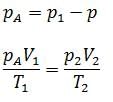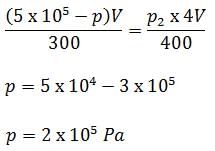JEE Exam > JEE Questions > The volumes of containers A and B, connected ...
Start Learning for Free
The volumes of containers A and B, connected by a tube and a closed valve are V and 4 V, respectively. Both the containers A and B have the same ideal gas at pressures (temperatures) 5.0 ×105 Pa(300 K) and 1.0 ×105Pa (400 K), respectively. The valve is opened to allow the pressure to equalise, but the temperature of each container is kept constant at its initial value. Find the common pressure in the containers.
- a)2.5 × 105 Pa
- b)2.0 × 105 Pa
- c)3.0 × 105 Pa
- d)1.5 × 105 Pa
Correct answer is option 'B'. Can you explain this answer?
Verified Answer
The volumes of containers A and B, connected by a tube and a closed va...

∴ p1 > p2 so, the equalise pressure of the p is reduced from p1

Given, T1 = 300
T2 = 400
V2 = 4V
p1 = 5 x 105

Most Upvoted Answer
The volumes of containers A and B, connected by a tube and a closed va...
∴ p1 > p2 so, the equalise pressure of the p is reduced from p1
Given, T1 = 300
T2 = 400
V2 = 4V
p1 = 5 x 105
Given, T1 = 300
T2 = 400
V2 = 4V
p1 = 5 x 105
Free Test
FREE
| Start Free Test |
Community Answer
The volumes of containers A and B, connected by a tube and a closed va...
Given data:
- Volume of container A = V
- Volume of container B = 4V
- Initial pressure and temperature of container A = 5.0 × 10^5 Pa and 300 K
- Initial pressure and temperature of container B = 1.0 × 10^5 Pa and 400 K
Pressure equalisation:
- When the valve is opened, the gas will flow from the higher pressure container (A) to the lower pressure container (B) until the pressure is equalized.
- Since the temperature of both containers remains constant during this process, according to Gay-Lussac's law, the pressure and temperature are directly proportional.
Calculation:
- Let P be the common pressure in both containers after equalization.
- Using the ideal gas law, we can write for container A initially: P1V = nRT1
- And for container B initially: P2(4V) = nR(400)
- After equalization, the total moles of gas in both containers remain constant. So, nR(300) = nR(400)
- Therefore, P1V = P(4V)
- P1 = 4P
- Since P1 = 5.0 × 10^5 Pa, we have: 5.0 × 10^5 = 4P
- Solving for P gives P = 1.25 × 10^5 Pa = 2.0 × 10^5 Pa
Therefore, the common pressure in the containers after equalization is 2.0 × 10^5 Pa, which corresponds to option B.

|
Explore Courses for JEE exam
|

|
Similar JEE Doubts
The volumes of containers A and B, connected by a tube and a closed valve are V and 4 V, respectively. Both the containers A and B have the same ideal gas at pressures (temperatures) 5.0 ×105Pa(300 K) and 1.0 ×105Pa (400 K), respectively. The valve is opened to allow the pressure to equalise, but the temperature of each container is kept constant at its initial value. Find the common pressure in the containers.a)2.5 × 105Pab)2.0 × 105Pac)3.0 × 105Pad)1.5 × 105PaCorrect answer is option 'B'. Can you explain this answer?
Question Description
The volumes of containers A and B, connected by a tube and a closed valve are V and 4 V, respectively. Both the containers A and B have the same ideal gas at pressures (temperatures) 5.0 ×105Pa(300 K) and 1.0 ×105Pa (400 K), respectively. The valve is opened to allow the pressure to equalise, but the temperature of each container is kept constant at its initial value. Find the common pressure in the containers.a)2.5 × 105Pab)2.0 × 105Pac)3.0 × 105Pad)1.5 × 105PaCorrect answer is option 'B'. Can you explain this answer? for JEE 2025 is part of JEE preparation. The Question and answers have been prepared according to the JEE exam syllabus. Information about The volumes of containers A and B, connected by a tube and a closed valve are V and 4 V, respectively. Both the containers A and B have the same ideal gas at pressures (temperatures) 5.0 ×105Pa(300 K) and 1.0 ×105Pa (400 K), respectively. The valve is opened to allow the pressure to equalise, but the temperature of each container is kept constant at its initial value. Find the common pressure in the containers.a)2.5 × 105Pab)2.0 × 105Pac)3.0 × 105Pad)1.5 × 105PaCorrect answer is option 'B'. Can you explain this answer? covers all topics & solutions for JEE 2025 Exam. Find important definitions, questions, meanings, examples, exercises and tests below for The volumes of containers A and B, connected by a tube and a closed valve are V and 4 V, respectively. Both the containers A and B have the same ideal gas at pressures (temperatures) 5.0 ×105Pa(300 K) and 1.0 ×105Pa (400 K), respectively. The valve is opened to allow the pressure to equalise, but the temperature of each container is kept constant at its initial value. Find the common pressure in the containers.a)2.5 × 105Pab)2.0 × 105Pac)3.0 × 105Pad)1.5 × 105PaCorrect answer is option 'B'. Can you explain this answer?.
The volumes of containers A and B, connected by a tube and a closed valve are V and 4 V, respectively. Both the containers A and B have the same ideal gas at pressures (temperatures) 5.0 ×105Pa(300 K) and 1.0 ×105Pa (400 K), respectively. The valve is opened to allow the pressure to equalise, but the temperature of each container is kept constant at its initial value. Find the common pressure in the containers.a)2.5 × 105Pab)2.0 × 105Pac)3.0 × 105Pad)1.5 × 105PaCorrect answer is option 'B'. Can you explain this answer? for JEE 2025 is part of JEE preparation. The Question and answers have been prepared according to the JEE exam syllabus. Information about The volumes of containers A and B, connected by a tube and a closed valve are V and 4 V, respectively. Both the containers A and B have the same ideal gas at pressures (temperatures) 5.0 ×105Pa(300 K) and 1.0 ×105Pa (400 K), respectively. The valve is opened to allow the pressure to equalise, but the temperature of each container is kept constant at its initial value. Find the common pressure in the containers.a)2.5 × 105Pab)2.0 × 105Pac)3.0 × 105Pad)1.5 × 105PaCorrect answer is option 'B'. Can you explain this answer? covers all topics & solutions for JEE 2025 Exam. Find important definitions, questions, meanings, examples, exercises and tests below for The volumes of containers A and B, connected by a tube and a closed valve are V and 4 V, respectively. Both the containers A and B have the same ideal gas at pressures (temperatures) 5.0 ×105Pa(300 K) and 1.0 ×105Pa (400 K), respectively. The valve is opened to allow the pressure to equalise, but the temperature of each container is kept constant at its initial value. Find the common pressure in the containers.a)2.5 × 105Pab)2.0 × 105Pac)3.0 × 105Pad)1.5 × 105PaCorrect answer is option 'B'. Can you explain this answer?.
Solutions for The volumes of containers A and B, connected by a tube and a closed valve are V and 4 V, respectively. Both the containers A and B have the same ideal gas at pressures (temperatures) 5.0 ×105Pa(300 K) and 1.0 ×105Pa (400 K), respectively. The valve is opened to allow the pressure to equalise, but the temperature of each container is kept constant at its initial value. Find the common pressure in the containers.a)2.5 × 105Pab)2.0 × 105Pac)3.0 × 105Pad)1.5 × 105PaCorrect answer is option 'B'. Can you explain this answer? in English & in Hindi are available as part of our courses for JEE.
Download more important topics, notes, lectures and mock test series for JEE Exam by signing up for free.
Here you can find the meaning of The volumes of containers A and B, connected by a tube and a closed valve are V and 4 V, respectively. Both the containers A and B have the same ideal gas at pressures (temperatures) 5.0 ×105Pa(300 K) and 1.0 ×105Pa (400 K), respectively. The valve is opened to allow the pressure to equalise, but the temperature of each container is kept constant at its initial value. Find the common pressure in the containers.a)2.5 × 105Pab)2.0 × 105Pac)3.0 × 105Pad)1.5 × 105PaCorrect answer is option 'B'. Can you explain this answer? defined & explained in the simplest way possible. Besides giving the explanation of
The volumes of containers A and B, connected by a tube and a closed valve are V and 4 V, respectively. Both the containers A and B have the same ideal gas at pressures (temperatures) 5.0 ×105Pa(300 K) and 1.0 ×105Pa (400 K), respectively. The valve is opened to allow the pressure to equalise, but the temperature of each container is kept constant at its initial value. Find the common pressure in the containers.a)2.5 × 105Pab)2.0 × 105Pac)3.0 × 105Pad)1.5 × 105PaCorrect answer is option 'B'. Can you explain this answer?, a detailed solution for The volumes of containers A and B, connected by a tube and a closed valve are V and 4 V, respectively. Both the containers A and B have the same ideal gas at pressures (temperatures) 5.0 ×105Pa(300 K) and 1.0 ×105Pa (400 K), respectively. The valve is opened to allow the pressure to equalise, but the temperature of each container is kept constant at its initial value. Find the common pressure in the containers.a)2.5 × 105Pab)2.0 × 105Pac)3.0 × 105Pad)1.5 × 105PaCorrect answer is option 'B'. Can you explain this answer? has been provided alongside types of The volumes of containers A and B, connected by a tube and a closed valve are V and 4 V, respectively. Both the containers A and B have the same ideal gas at pressures (temperatures) 5.0 ×105Pa(300 K) and 1.0 ×105Pa (400 K), respectively. The valve is opened to allow the pressure to equalise, but the temperature of each container is kept constant at its initial value. Find the common pressure in the containers.a)2.5 × 105Pab)2.0 × 105Pac)3.0 × 105Pad)1.5 × 105PaCorrect answer is option 'B'. Can you explain this answer? theory, EduRev gives you an
ample number of questions to practice The volumes of containers A and B, connected by a tube and a closed valve are V and 4 V, respectively. Both the containers A and B have the same ideal gas at pressures (temperatures) 5.0 ×105Pa(300 K) and 1.0 ×105Pa (400 K), respectively. The valve is opened to allow the pressure to equalise, but the temperature of each container is kept constant at its initial value. Find the common pressure in the containers.a)2.5 × 105Pab)2.0 × 105Pac)3.0 × 105Pad)1.5 × 105PaCorrect answer is option 'B'. Can you explain this answer? tests, examples and also practice JEE tests.

|
Explore Courses for JEE exam
|

|
Signup for Free!
Signup to see your scores go up within 7 days! Learn & Practice with 1000+ FREE Notes, Videos & Tests.
























